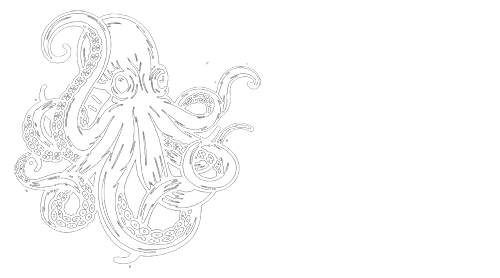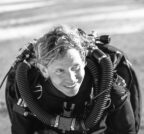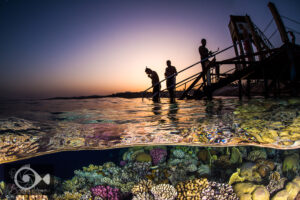Every underwater photographer aspires to develop a style that sets them apart from everyone else. Some incorporate interesting techniques into their bag of tricks while others look for ways to shoot a subject that is unique. Henley Spiers is one of those forward-thinking individuals that is able to combine his skills to produce some truly breathtaking images.

Hailing from London, England, this half-French half-Brit has spent years living abroad only to return recently to his homeland in the U.K. A scuba diving certification when he was a young teenager ensured Henley would enjoy a lifetime exploring underwater. But underwater photography would be a skill for a bit later in his underwater life.

As a scuba diving instructor, Henley carried a point-and-shoot camera with him for a couple of years to document dives, but about 6 years ago, he reached a turning point. He was trying out a mirrorless rig with a strobe during a trip to Lembeh. The colours and sharpness of the images was beyond compare to the results from his point-and- shoot camera. At that moment, he began to fall in love with underwater photography. He purchased an Olympus EM5, housing, and strobes and took that kit to his next job as a dive manager at a new center in Saint Lucia. The bug bit hard from then on, and he used every opportunity he could to shoot underwater. In 2016, Henley moved from being a full-time dive instructor to underwater photographer.

Because Saint Lucia is not especially rich in large pelagic life, Henley started out with macro photography. These days, he is slightly more drawn to wide angle photography and the ability to paint a broader canvas. However, he says he would never want to have to choose one over the other as both macro and wide-angle photography provide interesting possibilities. Currently, Henley is intrigued by the Pacific coast of central America. He has gained success there, seeking out pelagic events such as aggregating marlin, and dolphin super pods.

Curiosity has served Henley well as he is interested in the possibilities that lie, more or less, in any body of water. This can be documented by his numerous awards in several prestigious competitions. Highlights include regularly being awarded in the Underwater Photographer of the Year contest, including two category wins; winning in the Open Geographic David Doubilet Portfolio Award; and winning the Blancpain Festisub Duo Mer for the last two years running. These are a mere few of his accomplishments, however as his awards seem to have no end. In addition to his successes in competitions, Henley’s work is regularly featured on magazine covers, most notably Diver Magazine.

Henley’s kit includes a Nikon D850 camera, Nauticam housing, Inon Z240 and Z330 strobes, as well as ONE UW 160 strobes. He has a special appreciation for the Nauticam Wide Angle Conversion Port-1. He says it is sharper than any other lens and optics combination he owns or knows of, and it allows him to open up the aperture a bit more without sacrificing corners (a key consideration with a full frame camera.) While these tools serve him well, it is not the tools that make the photographer. When asked what helped make him a better underwater photographer, Henley said, “Learning to be patient and changing my whole way of diving. You cannot expect wildlife to ‘perform’ the moment you show up, so being patient and willing to spend all dive (or even multiple dives) in pursuit of a single image will do a lot to boost your photographic results.” This philosophy seems to have paid off as you can see by his images.

Most underwater photographers will attest that trying to get a challenging shot is what drives them to strive for greatness. Henley’s ability to try techniques such as the motion blur on a macro subject (above) has catapulted him to the forefront. But sometimes it is not the challenge of the shot, but the challenge of the circumstances that is exciting to the photographer. Henley had this to say about his most challenging subject, the bumphead parrotfish spawning in Palau; “Hundreds of bumpheads aggregate in the early morning to mate, it’s one of the most amazing things I’ve ever seen underwater but tremendously tricky photographically. There is very little light, and plenty of opportunity for backscatter as the water column fills with eggs and sperm. The action lasts less than an hour and is fast and furious. You cannot swim fast enough really and must hope to get lucky and have the bumpheads come close to you as they rise in unison during the peak of the action. I would like to go back and try that one again, as I don’t feel my results reflect how incredible the moment was.”
Exploring techniques is one of Henley’s strengths and his admirers appreciate his efforts. He is especially drawn to the use of slow shutter to incorporate motion, as well as minimalist black and white compositions. These techniques are becoming a part of his photographic style and set him apart from others.
Henley’s advice to new photographers is to remember to have fun! He says that if you are not satisfied with your results, there are a whole host of resources and teachers out there. Use them!

Henley Spiers is co-author of “Black is the New Blue II”, and “Guide to Cebu, which he wrote with his wife, Jade Hoksbergen (available currently in the Philippines and in international markets soon.) He is the owner of Henley Spiers Photography and teaches underwater photography through unique diving experiences and trips. More of Henley’s beautiful photographs can be seen on his website at www.henleyspiers.com.
You can follow him on Instagram @henleyspiersphoto and on Facebook @henleyspiersphotography
If you would like to be featured as an under water photographer, please email waterdogphotography@gmail.com and request more info. We are looking forward to seeing some great work on this page!
Subscribe now!
The images on this page are copyright protected by the featured photographer and may not be copied or used without written permission. All other images and content are copyright protected by Brook Peterson and may only be used with written permission. Please do not copy or print them. To discuss terms for using these images, please contact Brook Peterson at waterdogphotography@gmail.com
© Brook Peterson 2020






